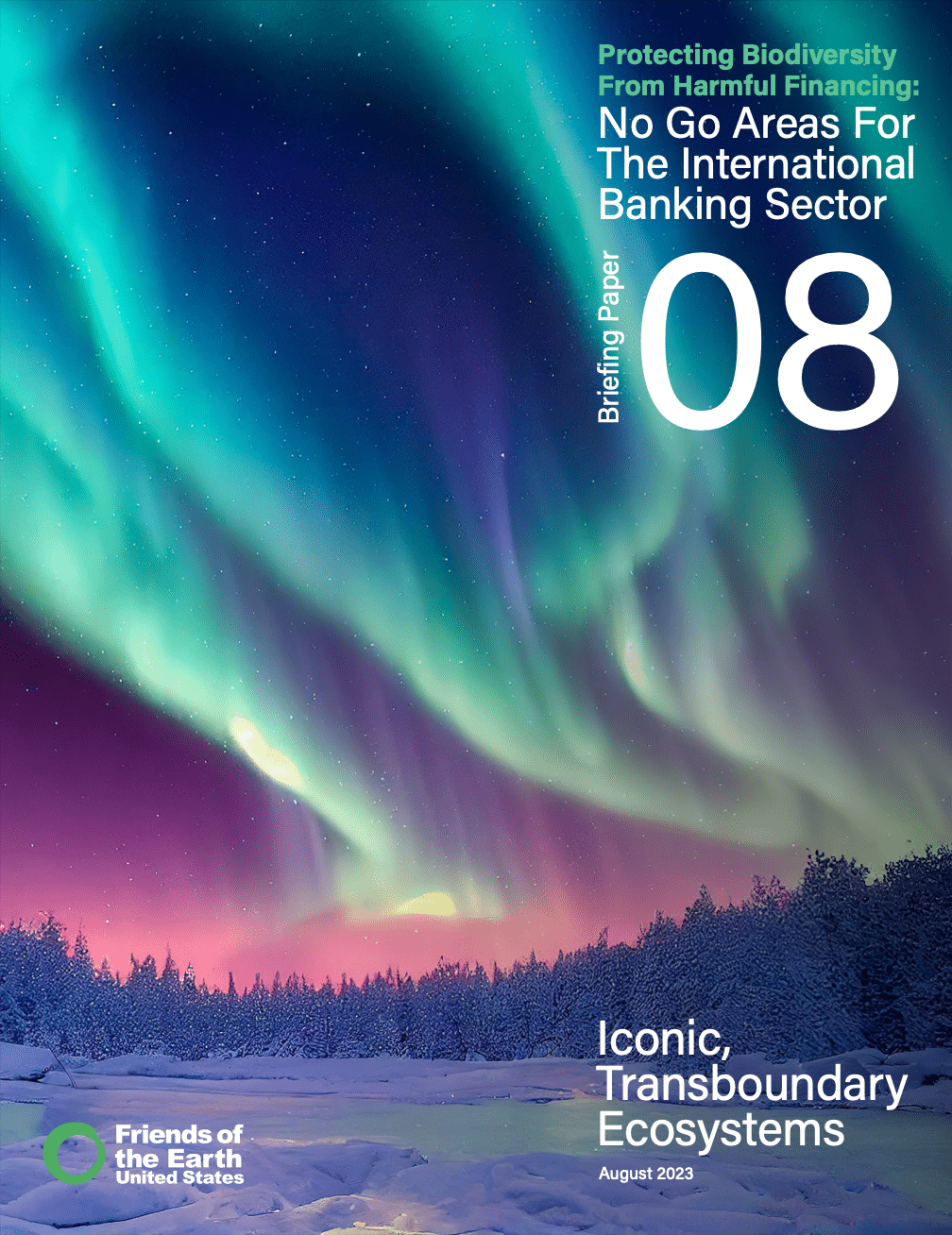- Home
- Sustainable Economic Systems
- Environmental & Social Standards
- Iconic, Transboundary Ecosystems
Iconic, Transboundary Ecosystems
On International Indigenous Peoples Day, new briefing paper calls on banks and financiers to make iconic transboundary ecosystems off limits to harmful financing
In recognition of World’s Indigenous Peoples Day, Friends of the Earth US has published a new briefing paper called, “Protecting biodiversity from harmful financing: Iconic, transboundary ecosystems.” The briefing paper explains why it is critical for banks and financiers to prohibit direct and indirect financing to harmful activities which negatively impact iconic, transboundary ecosystems.
Iconic, transboundary ecosystems are regions or habitats treasured for their ecological, aesthetic, and cultural value. They are often transboundary in nature and prominent places for conservation efforts, such as the Amazon and the Arctic. They are also home to Indigenous Peoples and local communities, who are increasingly seen as the best stewards for protecting biodiversity.
As transboundary ecosystems span across different jurisdictions and management, it is critical that banks and financiers take responsibility to ensure that their financing does not negatively impact ecosystem integrity. In other words, the protection of iconic, transboundary ecosystems demands protecting the entire ecosystem, rather than just pockets or fragments. For instance, iconic ecosystems like the Amazon may soon collapse due to fragmentation caused by deforestation and extractive activities simultaneously occurring across Amazon countries.
This paper offers key takeaways for banks and financiers on how to protect iconic, transboundary ecosystems and the Indigenous ad local communities who live there.
Key takeaways of this paper include:
- Banks and financiers must strengthen protections of iconic, transboundary ecosystems in order to prevent the fragmentation of such areas.
- The Banks and Biodiversity Initiative recommends that banks and financiers draw on our proposed definition of iconic, transboundary, ecosystems as those “with unique, superlative natural, biodiversity, and/or cultural value which may sprawl across state boundaries, and thus may not be wholly or officially recognized or protected by host countries or international bodies.”
- Banks and financiers should prohibit harmful financing to iconic, transboundary ecosystems, particularly the Amazon, Arctic, Sundarbans, Coral Triangle and Albertine Rift, amongst others. This requires that due diligence processes account for robust, accurate, assessments which account for ecosystem integrity and ecosystem fragmentation risks.
- Current and historical bank financing has already led to the fragmentation and devastation of iconic, transboundary, ecosystems critical for climate regulation and biodiversity conservation, including the Amazon, Arctic, Sundarbans, Coral Triangle, and Albertine Rift, amongst others.
- While some banks have established limited protections on the Amazon and Arctic, particularly among commercial banks, the international banking sector writ large should develop explicit and strong policies to protect iconic, transboundary, ecosystems.
- Banks should reference and assess multiple sources in decision making around investments in iconic areas. In particular different approaches to Arctic mapping are important and banks should be aware to assess various sources when assessing the risks of a particular proposed project or activity there.
- Establishing exclusionary policies for iconic, transboundary, ecosystems can be an effective way for banks and financiers to harmonize institutional climate and biodiversity targets by protecting the key ecosystems with high climate regulatory and biodiversity values simultaneously.
- Indigenous Peoples and local communities play a critical role in protecting climate regulatory and high biodiversity ecosystems.
- Banks and financiers should improve or establish strong Indigenous Peoples policies which protect the rights to self-determination and sovereignty.
- Banks and financiers should require free, prior, informed consent as a right to Indigenous Peoples, and as a best practice for consulting local communities.
This paper is part of Friends of the Earth US’ new Protecting Biodiversity from Harmful Financing briefing paper series, which underscores why banks and financiers should exclude harmful, unsustainable financing to activities and projects which impact critical, at-risk ecosystems.
Each briefing paper is dedicated to a key area as identified by the Banks and Biodiversity Initiative’s eight proposed No Go Areas. This paper is o iconic, transboundary ecosystems, which is paper 08 of the series.
Full briefing paper series includes:
- No Go area 3: Key Biodiversity Areas and habitats with endangered and endemic species
- No Go area 4: Primary and vulnerable secondary forests
- No Go area 5: Free flowing rivers
- No Go area 6: Protected or at-risk marine and coastland ecosystems
- No Go area 7: Areas where Free, Prior and Informed Consent has not been obtained by Indigenous Peoples and local communities
Friends of the Earth US is part of the Banks and Biodiversity Initiative, a civil society coalition which advocates that banks and financiers strengthen their biodiversity policies and practices in order to halt and reverse biodiversity loss. Learn more at banksandbiodiversity.org.

